
All material by ATW may be used under the terms of a
Public Domain Dedication.
| Glossary | ||
| Eukarya | Glossary S-Z |
| Life | Time |
Schizont a (usually large) cell which is not infectious, but which divides rapidly, with little growth, into a large number of small merozoites, specialized 2n infective forms.
Solute any molecule dissolved in water (or any liquid medium).
Sporoblast probably the same as sporozont.
Sporogony reproduction by multiple fission and growth of a spore or zygote resulting in a large number of 2n sporozoites -- essentially fully formed infectious cells. Asexual reproduction. As opposed to gamogony (resulting in 1n gametes) and merogony (a single large cell, a schizont, splits into many small specialized infective forms, or merozoites).
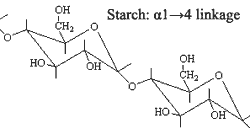
Sporoplasm the material, other than the protein coat, cell, wall or containing membrane, which an infectious agent actually injects into a host cell.
Sporozont a replicative intermediate form of cell which matures into, or which, by sporogony, gives rise to, definitive spores. The terms sporozont, sporozoont, sporont, and sporoblast appear to be synonymous.
Starch a polymer of glucose. Poly(α1→4)-D-glucose. Cellulose is chemically identical, but has a beta linkage between adjacent glucose monomers.
Stercomare long branching strings of fecal matter that are retained in the test of Xenophyophorea. In some species these can make up a significant part of the test.
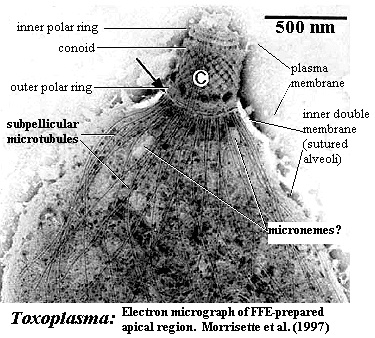
Subpellicular microtubules in Apicomplexa, a system of singlet microtubules which extend like lines of longitude from regularly spaced attachment points on the outer polar ring. Morisette et al. (1997).
Synapomorphy a character which is shared by all basal members of a clade and is derived from their common ancestor. A synapomorphy may be secondarily lost in later descendants. Only a synapomorphy may be used to infer phylogeny.
Synonymous when used in connection with coding sequences in nucleic acids, the term refers to different nucleotide sequences which code for the same amino acid. So, for example, the mRNA sequences GUU and GUC both code for valine. A mutation in the third position from U to C is a synonymous change since it results in the same protein. Changes in the third codon position are usually synonymous.
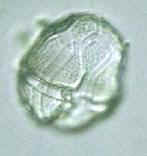
Tectic surface-living.
Theca a sheath or covering.
Thylakoid membrane: a unit of a stacked, lamellar membrane system in most cyanobacteria on which photosynthesis is carried out.
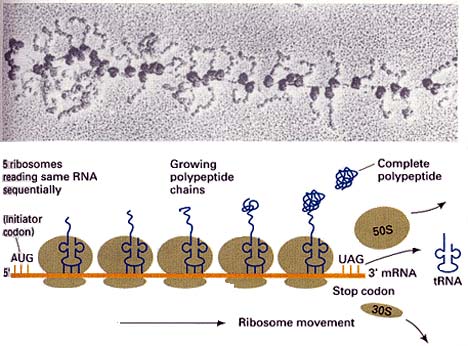
Translation the process whereby the genetic code carried by mRNA is read and used to construct proteins. This process is carried out by ribosomes. The ribosomes recruit appropriate 4S or transfer RNAs (tRNAs) which are conceptually) molecules with an amino acid at one end and an "anticodon" at the other. The anticodon consists of three nucleotide bases which are the complement of the codon which codes for the tRNA's amino acid. Thus, for example, proline is coded by the sequence CCA. The corresponding tRNApro would then bear a proline amino acid at one end, and the complementary sequence, i.e. GGU, at the other. The ribosome sits on the mRNA molecule. If the ribosome detects that the tRNA bases form complementary base pairs with the next mRNA triplet in line, it clips the amino acid off the tRNA and ads it to the growing protein. It then moves up three bases on the mRNA and looks for the next matching tRNA.
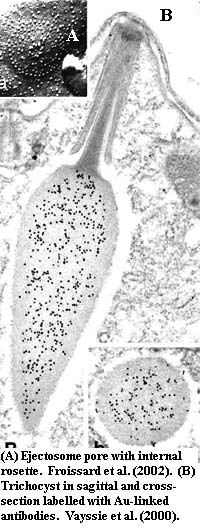
Trichocyst a type of ejectosome organelle producing hair like fibers for offensive and defensive purposes in Alveolata. A trichocyst is assembled as an elongate, spindle-shaped body which differentiates into an electron-dense cortex and a crystalline core. Vayssié et al. (2000). The trychocyst then docks with one of many specific sites on the cell membrane which show a characteristic double ring of 8 nm particles. When the trichocyst has docked (via a fibrous tube) with the double ring structure, a rosette of additional particles appears at the center of the double circle (in FFE preparations). Froissard et al. (2002). When an appropriate release stimulus is detected, the cell releases sequestered calcium ions into the cytoplasm which trigger rapid release of the trichocyst contents into the medium. Erxleben & Plattner (1994). The mechanism in Alveolata, described here, shares many important molecular details and protein homologies with the formation of secretory granules in Metazoa. Burgoyne & Morgan (2003).
Trophozoite a protozoan in a growing, vegetative form as distinguished from one in a reproductive or resting form.
Tubulin the principal protein component of microtubules.
Tubulocristate of mitochondria, having cristae of tubular shape.
Turgor pressure see osmotic pressure.
V4 region a very large variable region near the middle of the 18S rRNA molecule (see image at that entry). The length, sequence, and secondary structure of this region are all quite variable. This region has been of particular interest in phylogenetic work because it is large enough to develop phylogenetically distinctive secondary structures: the presence, size, and position of loops and double-stranded regions. Comparing sequence data is often futile because of rampant long-branch attraction problems. That is, a proportion of the sites (one often doesn't know how many or which ones) in most proteins and nucleic acids are mutating at rapid rates or have done so at some point in the past. The sequence data at those positions is therefore useless and quite often misleading. "Morphological" characters, including information embodied in secondary structure, tends to change incrementally, and on time scales useful to the evolutionary biologist.
Xenoma a complex in which an intracellular parasite has taken over metabolic control of a host cell so that the host becomes a hypertrophied factory for production of the parasite.
Xenophyae esp., of Xenophyophorea, foreign particles incorporated into an organism's test.
Xylan cell wall polysaccharide containing a backbone of β(1-4)-linked xylose residues. Side-chains of 4-O-methylglucuronic acid, arabinose, and acetyl groups are present in varying amounts.

Zeaxanthin a carotene photosynthetic pigment found in glaucophytes and red algae. Zeaxanthin absorbs light in the blue region of the spectrum. Perhaps more importantly, it is active in controlling potential damage from high light intensities by scavenging free radicals (Baroli et al., 2003), and by dissipating excess energy through "short-circuiting" chlorophyll excited states (Aspinall-O'Dea et al., 2002).
Zooxanthellae a generic term for small, autotrophic bacteria or protists which are found as endosymbionts of metazoans nudibranchs, corals, etc.) and radiolarians.